This was published 6 years ago
Hong Kong Free Tours explore the dark side of the city
By CHARLOTTE GRAHAM
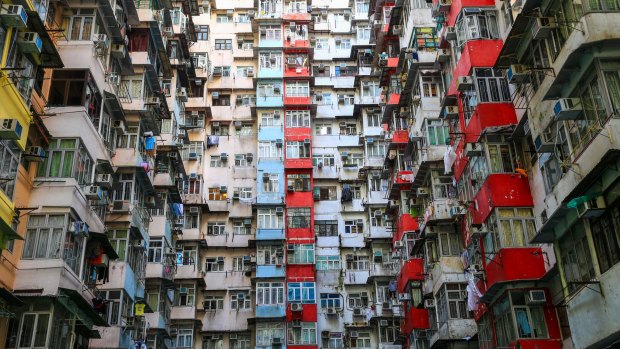
Hong Kong has one of the world's most expensive housing markets.Credit: Shutterstock
Among the crowds on Kweilin Street in the run-down Hong Kong neighborhood of Sham Shui Po, Alla Lau darted between street signs, peering at the backs of them until she found what she was looking for. She beckoned a group of tourists, mostly white, in flip-flops and with American accents.
"There," Lau said, pointing to a handwritten white sticker in Chinese characters that referred to the grimy building across the street. It was an advertisement for one of Hong Kong's notorious cage apartments, where, for as little as $HK1200 a month (about $154), people could rent a cage to sleep in. The cages are stacked three deep and offer barely enough space to sit up in.
The group Lau led had signed up for a tour of the less glamorous underbelly of this fabulously wealthy city. Over the course of three hours, tourists learned about Hong Kong's underpaid foreign domestic workers, its freewheeling street vendors and the suicides afflicting young students pressured by their parents to succeed in school.
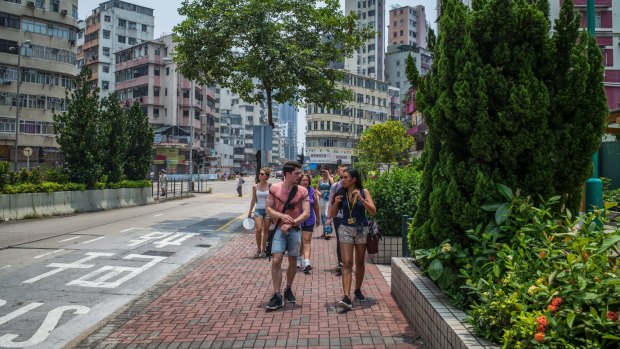
Alla Lau, right, a travel guide, right, from Hong Kong Free Tours, leads tourists through the Sham Shui Po section of Hong Kong.Credit: New York Times
Despite the horrid conditions in the cage apartments, Lau said, they still were not cheap. Per square metre, the monthly rent was more than that of the costlier apartments in Hong Kong, one of the world's most expensive housing markets, and many people living in the cages make far less than the city's monthly median income, roughly HK$12,000 a month.
During the eight or nine tours she leads a week, Lau, 26, gathers people at the subway station in Mong Kok, a teeming area where there were clashes last summer when the police tried to crack down on street hawkers. Greeting tourists in a neon jacket and with a wide smile, she gives them brightly coloured maps. A recent tour first seemed like any other as she directed her group past the street vendors selling goldfish in plastic bags.
But there was already an edge to the trip.
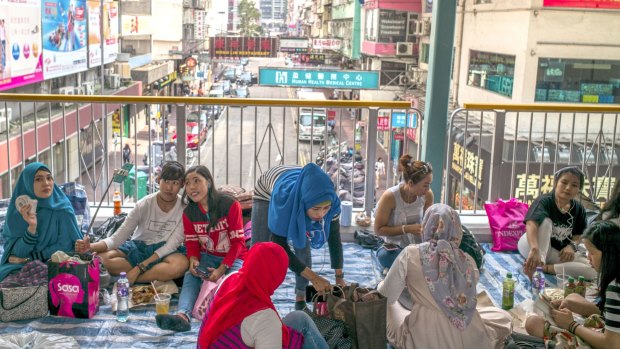
A meeting point for Hong Kong Free Tours and also where domestic workers gather to spend their day off, on a skybridge in the Mong Kok area.Credit: New York Times
Shepherding the tourists past Filipino and Indonesian domestic servants, Lau quietly told her group that these women were not covered by Hong Kong's minimum wage; different, lower pay scales applied to them. Tourists calculated the amount into their local currencies and expressed surprise and dismay.
Lau was inspired to become a tour guide in Hong Kong while backpacking around Europe; she took a tour of Sofia, Bulgaria, that highlighted the city's darker side.
Determined to bring a similar experience to Hong Kong, she joined a tour company as a guide in her native city, but she was disappointed that the script she was given did not delve beneath the surface. She was not interested in telling tourists where to shop.
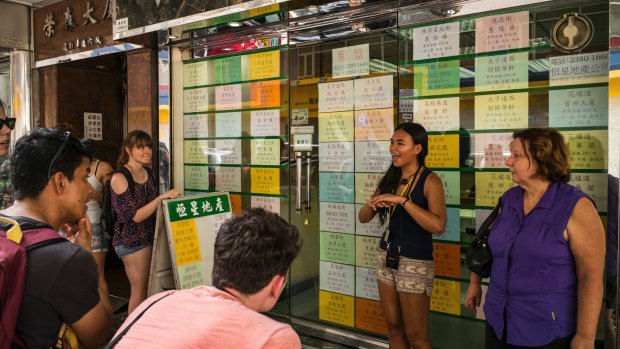
As other tourists flock to wealthy shopping districts, some learn from guides like Lau about Hong Kong's underpaid domestic workers and volatile politics. Credit: New York Times
Lau jumped ship to Hong Kong Free Tours when she was offered the chance to share with visitors the problems she and her friends faced, including the struggle to make ends meet.
"People come to Hong Kong for three or four days and see Tesla, Mercedes, skyscrapers in Central, all the things the government tries so hard to promote," she said.
"If I was a tourist, I'd see those things, how expensive everything is here, and think, 'Hong Kong people must have a really good life,'" she continued. "That's one side of Hong Kong. It isn't telling a lot of people's stories."
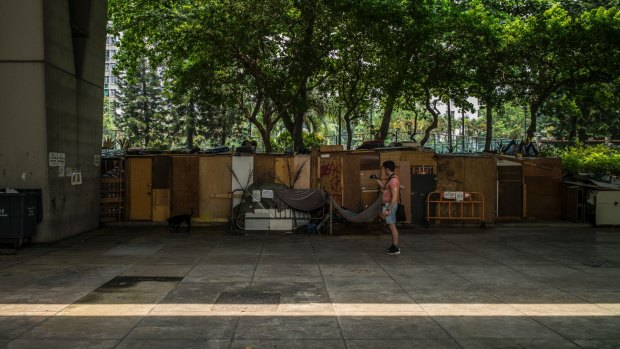
A tourist takes photos of makeshift homeless shelters, while on a tour with Alla Lau from Hong Kong Free Tours.Credit: Lam Yik Fei
As the tour wound deeper into Kowloon, the broad peninsula that points toward the sparkling towers of Hong Kong Island, Lau discussed the city's housing crisis. She stopped outside real estate agencies to explain the prices, instead of taking the group down the "sneaker street" favoured by bargain-seeking tourists.
Ducking into the foyer of a landmark-listed building that houses a training school, Lau talked about the intense pressure on students, which, she said, was partly to blame for the city's youth suicide rate.
She led the group through ramshackle, makeshift shelters on Tung Chau Street, a homeless community on the edge of Sham Shui Po, first warning people not to take photos.
"This is their home," she said.
Alessandro Dutto, 23, and Andrea Pertoldi, 24, two Italian backpackers, showed up after seeing a flyer for the tour in their hostel, even though a fellow tourist told them not to bother because there was "nothing to see" in this part of the city.
"It was one of the most interesting things we could have done here," Pertoldi said.
When the three-hour walking tour ended, Lau, still smiling, collected tips; the tours are free, but customers can choose to pay. Some disappeared back into Hong Kong's subway system, where they could emerge 10 minutes later back in the heart of the island's wealthy Central shopping district, with its air-conditioned Louis Vuitton and Armani stores.
Lau grew up not far from the tours she leads, in a public housing estate in Wong Tai Sin. There, her parents live in the same two-bedroom apartment where she once shared a bedroom with her sister and brother.
Her life is now much easier than those of her parents at her age, but Hong Kong's high cost of living means the glittering central mecca that tourists frequent is out of her reach.
"No one I know goes for lunch in Central or Admiralty," she said of the main business area on Hong Kong Island.
One topic she addresses in her tour is the volatile political climate. Lau, who slept in the streets of central Hong Kong for a few weeks in 2014 as part of the Occupy movement, said the removal of four pro-democracy lawmakers from office in July had so angered and demoralised people she knew that some were thinking of leaving the city.
During the next day's tour, she added a dose of the latest political developments, hoping, she said, that when Hong Kong reaches another breaking point, the tourists will see it on the news and feel a connection to the place.
"This city is not going to go quietly, the way that the government wanted it to," she said. "There is anger here, and something has to happen, something big. I don't know if it will be protests, demonstrations, revolution or something else."
Cheryl Dilks, originally from Boulder, Colorado, and now living in Guam, took the tour while visiting Hong Kong for the first time. She said it was refreshing to hear Lau's perspective.
"This side of the city would be hard to see as an outsider," she said. "It looks pretty clean everywhere, and you don't see a lot of homeless people. So for her to explain the inequities to us is something I was really thankful for."
See also: 20 reasons to visit Hong Kong
Sign up for the Traveller Deals newsletter
Get exclusive travel deals delivered straight to your inbox. Sign up now.